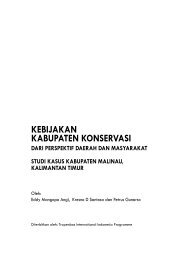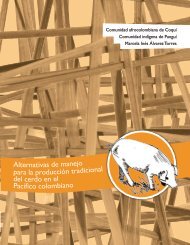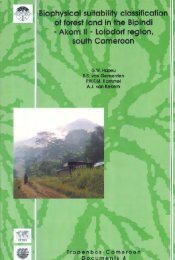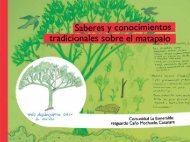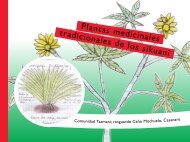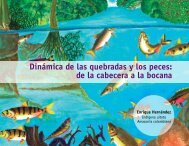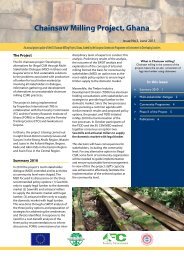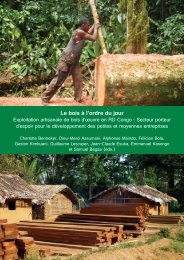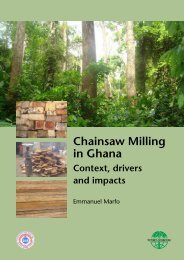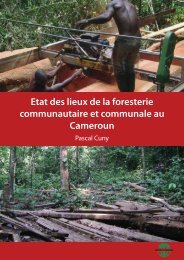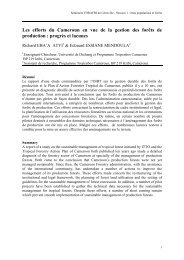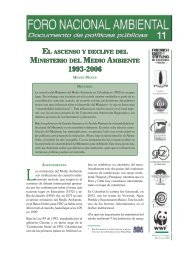Download the publication - Tropenbos International
Download the publication - Tropenbos International
Download the publication - Tropenbos International
Create successful ePaper yourself
Turn your PDF publications into a flip-book with our unique Google optimized e-Paper software.
Basal area = (1/2d)²π where d = DBH<br />
Relative density = Number of individuals of <strong>the</strong> species x 100<br />
Total number of individuals<br />
Relative dominance = Total basal area of <strong>the</strong> species x 100<br />
Total basal area of all species<br />
Relative frequency = Frequency of a species x 100<br />
Frequency of all species<br />
General introduction<br />
Importance value index (IVI) = Relative density + Relative dominance +<br />
Relative frequency<br />
Shannon diversity index (H') = - Σp i lnp i<br />
Where Pi = ni /N, ni = number of individuals of species, N = total number<br />
of individuals, and ln = log basen 1.5. OUTLINE OF THE BOOK<br />
The main objective of this <strong>the</strong>sis research is to provide baseline botanical<br />
information essential for <strong>the</strong> preparation of a strategic management plan for <strong>the</strong><br />
Campo-Ma’an Technical Operational Unit and particularly for <strong>the</strong> conservation and<br />
management of <strong>the</strong> National Park. In order to make significant contributions to this<br />
management and conservation process, a study of <strong>the</strong> vegetation and <strong>the</strong> flora of <strong>the</strong><br />
Campo-Ma’an rain forest is made. Chapter 1 presents a succinct state of knowledge<br />
of <strong>the</strong> Campo-Ma’an biodiversity. In Chapter 2, we identify, classify, describe and<br />
map <strong>the</strong> various vegetation types and analyse <strong>the</strong>ir structure and composition. Later<br />
on, we discuss <strong>the</strong> effect of environmental factors such as rainfall, altitude, soils,<br />
proximity to <strong>the</strong> sea and human disturbance that influence or delimit <strong>the</strong> found<br />
vegetation types.<br />
Chapter 3 deals with <strong>the</strong> diversity of <strong>the</strong> flora in <strong>the</strong> Campo-Ma’an rain forest. We<br />
search for correlation between tree species diversity and <strong>the</strong> diversity of o<strong>the</strong>r<br />
growth forms such as shrubs, herbs and lianas, in order to understand whe<strong>the</strong>r, in <strong>the</strong><br />
contest of <strong>the</strong> African tropical rain forest, tree species diversity tells it all. The<br />
Campo-Ma’an area falls within a series of postulated rain forest refugium in Central<br />
Africa. In Chapter 4, we study patterns in <strong>the</strong> distribution of sensitive bio-indicator<br />
forest species such as strict endemics and o<strong>the</strong>r well-known slow dispersal species to<br />
find out whe<strong>the</strong>r if <strong>the</strong> entire Campo-Ma’an area was part of a refugium or not.<br />
Special attention is given to <strong>the</strong>se taxa because of <strong>the</strong>ir biology (life strategy) and/or<br />
distribution (endemism) <strong>the</strong>y may act as indicators for refuge areas.<br />
In Chapter 5, <strong>the</strong> forest inventory data and taxonomic collections are used to<br />
examine <strong>the</strong> distribution and convergence patterns of strict and narrow endemic<br />
15



